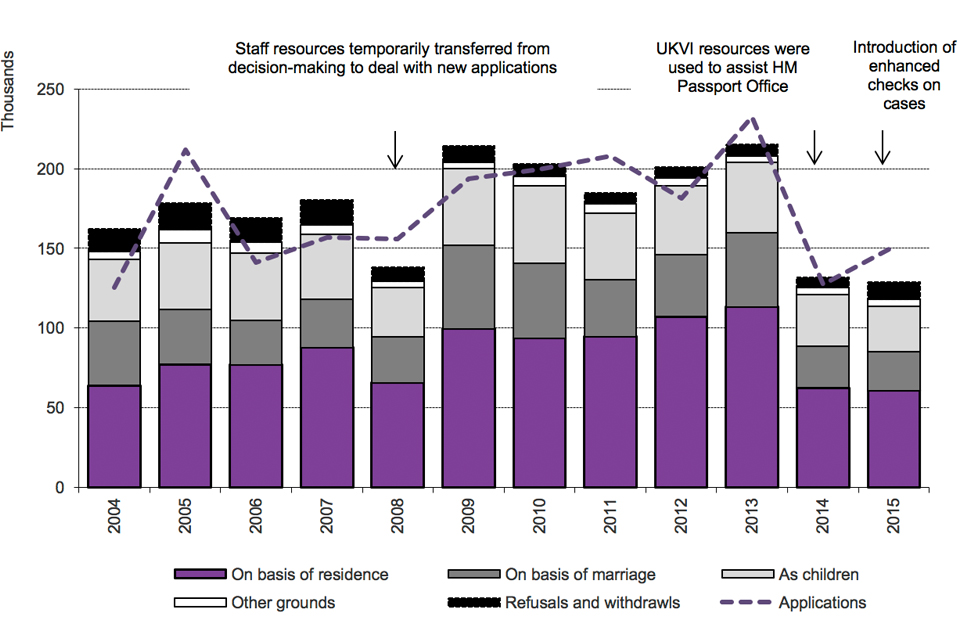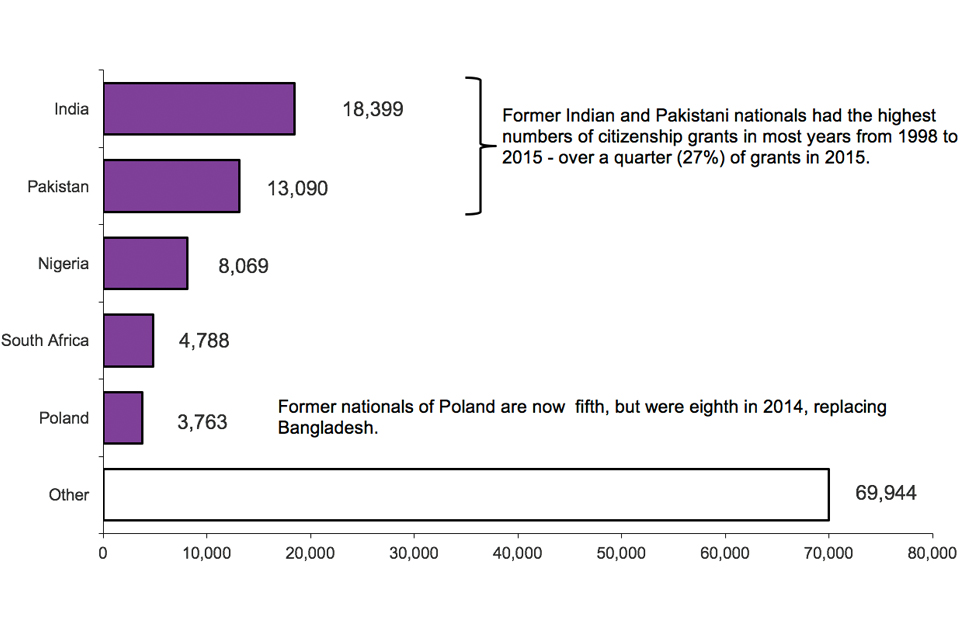Citizenship
Published 1 December 2016
Valid: 01 December 2016 to 22 February 2017
Data relate to the year ending September 2016 and all comparisons are with the year ending September 2015, unless indicated otherwise.
Back to ‘Immigration statistics July to September 2016’ content page.
This is not the latest release. View latest release.
1. Key facts
Applications for British citizenship were relatively stable, falling by less than 0.5% to 141,861 in the year ending September 2016. This included an 18% fall in applications from South African nationals (-1,038 to 4,703) which was offset by a 6% increase in applications from Indian nationals to (+1,256 to 23,020).
Applications from European Union (EU) nationals rose by 2% (+257 to 15,282) while applications made by non-EU nationals fell 1% (down 769 to 126,579).
There were 171,807 British citizenship decisions in the year ending September 2016, 38% more than the previous 12 months (124,927). Grants of British citizenship increased by 36% (+41,351 to 157,066), while refusals and withdrawals rose by 60% (+5,529 to 14,741). Higher numbers were refused or withdrawn, following the introduction of enhanced checks on cases requiring higher levels of assurance in April 2015, e.g. those cases with previous asylum refusals and cases with adverse immigration histories.
The 41,351 increase in grants of British citizenship reflects increases in numbers of people granted citizenship in all broad categories (residence, marriage, as children).
Variations in numbers of decisions can be affected by changes in resources and the mix of cases, as well as policy changes and application levels in earlier periods.
Grants and refusals of citizenship
| Year | Total decisions | Total grants | On basis of residence | On basis of marriage | As children | Other grounds | Refusals and withdrawals |
|---|---|---|---|---|---|---|---|
| Year ending September 2012 | 191,264 | 184,741 | 101,257 | 37,602 | 40,629 | 5,253 | 6,523 |
| Year ending September 2013 | 205,978 | 198,891 | 108,141 | 41,925 | 44,475 | 4,350 | 7,087 |
| Year ending September 2014 | 156,303 | 149,282 | 80,268 | 32,871 | 32,173 | 3,970 | 7,021 |
| Year ending September 2015 | 124,927 | 115,715 | 58,167 | 23,419 | 30,291 | 3,838 | 9,212 |
| Year ending September 2016 | 171,807 | 157,066 | 79,984 | 30,473 | 38,463 | 8,146 | 14,741 |
| Change: latest year | +46,880 | +41,351 | +21,817 | +7,054 | +8,172 | +4,308 | +5,529 |
| Percentage change | +38% | +36% | +38% | +30% | +27% | +112% | +60% |
Table notes
Source: Home Office, Immigration Statistics July to September 2016, Citizenship tables cz 01 q and cz 02 q.
‘Other grounds’ includes Entitlement and Discretionary registration as an adult, Entitlement and Discretionary registration on other grounds, and registration under Section 5 of the British Nationality Act 1981. See Citizenship table cz 07 and the user guide for more detail.
2. Long-term trends in applications for citizenship and grants and refusals
The chart below illustrates longer-term trends in applications for citizenship and grants and refusals.

Chart notes
Source: Home Office, Immigration Statistics July to September 2016, Citizenship tables cz 02 and cz 03. In 2008 staff resources were temporarily transferred from decision-making to deal with new applications. In 2014 UK Visas and Immigration (UKVI) resources were used to assist HM Passport Office. In 2015 enhanced checks on cases were introduced.
The number of grants of Citizenship in 2015 (118,053) was the lowest since 2001 (90,282). The increase in applications received during 2005 may have reflected people anticipating the introduction of the Knowledge of Life in the UK test on 1 November that year. Between 2009 and 2013 there was a general increase in applications and grants, which is likely in part to reflect increased grants of permission to stay permanently (known as ‘settlement’) up to 2010. After a period of residence, those granted settlement become eligible to apply for citizenship. The peak in 2013, when there were 207,989 grants, may have been partly due to some people anticipating the rule change to the English language element of the Life in the UK test as of 28 October 2013. See the Policy and Legislative Changes Timeline for further information. The number of grants was substantially lower in both 2014 and 2015.
Applications for British citizenship made in the year to September 2016 fell by less than 0.5% (down 512) compared to the previous 12 months. Within this total, applications from EU nationals rose by 2% (+257). As the table below shows, EU nationals were 3% of the total in the year to September 2008 and 11% in the year to September 2016. Increases in applications from EU nationals in recent years are likely to reflect immigration in earlier years by EU nationals.
Applications for citizenship, EU and non- EU nationals
| Total applications | Non-EU | EU nationals | EU nationals as % of total | |
|---|---|---|---|---|
| Year ending September 2008 | 147,053 | 142,225 | 4,828 | 3% |
| Year ending September 2009 | 181,772 | 175,480 | 6,292 | 3% |
| Year ending September 2010 | 201,581 | 192,853 | 8,728 | 4% |
| Year ending September 2011 | 209,913 | 200,980 | 8,933 | 4% |
| Year ending September 2012 | 185,991 | 176,094 | 9,897 | 5% |
| Year ending September 2013 | 206,340 | 190,006 | 16,334 | 8% |
| Year ending September 2014 | 163,468 | 146,940 | 16,528 | 10% |
| Year ending September 2015 | 142,373 | 127,348 | 15,025 | 11% |
| Year ending September 2016 | 141,861 | 126,579 | 15,282 | 11% |
| Change: latest year | -512 | -769 | +257 | |
| Percentage change | 0% | -1% | +2% |
Table notes
Source: Home Office, Immigration Statistics July to September 2016, Citizenship table cz 01 q a.
Series are based on current EU membership, i.e. Croatians included in EU total throughout.
See Citizenship table cz 01 q a and the user guide for more details.
Applications received from nationals of most EU states increased in the latter half of 2015, particularly in the fourth quarter of 2015, partly due people anticipating a change in the rules. After 12 November 2015, a person applying for citizenship who is claiming to have permanent residence as an EEA (European Economic Area) national or the family member of an EEA national must provide a permanent residence card or a document certifying permanent residence as evidence that they meet the requirement to be free of immigration time restrictions, reducing numbers eligible to apply immediately. Applications from EU nationals rose again in the second and third quarters of 2016, although to a lesser extent, whereas applications from non-EU nationals fell.
Applications for citizenship, EU national groups and all other nationalities
| Geographical region | 2015 Q2 | 2015 Q3 | 2015 Q4 | 2016 Q1 | 2016 Q2 | 2016 Q3 |
|---|---|---|---|---|---|---|
| Total EU | 3,650 | 4,183 | 5,347 | 2,833 | 3,138 | 3,964 |
| EU 14 | 1,254 | 1,528 | 1,659 | 1,044 | 1,303 | 1,929 |
| EU 2 | 764 | 779 | 1,140 | 605 | 565 | 630 |
| EU 8 | 1,580 | 1,807 | 2,473 | 1,148 | 1,214 | 1,352 |
| EU Other | 52 | 69 | 75 | 36 | 56 | 53 |
| Other regions | 32,164 | 30,190 | 35,651 | 38,221 | 27,436 | 25,271 |
| Total all regions | 35,814 | 34,373 | 40,998 | 41,054 | 30,574 | 29,235 |
Table notes
Source: Home Office, Immigration Statistics July to September 2016, Citizenship table cz 01 q a.
3. Grants of citizenship, by previous nationality
The chart below shows the top 5 previous nationalities granted citizenship.
(Total number of grants in 2015 was 118,053.)

Chart notes
Source: Home Office, Immigration Statistics July to September 2016, Citizenship table cz 06. Former Indian and Pakistani nationals had the highest numbers of citizenship grants in most years from 1998 to 2015, over a quarter (27%) of grants in 2015. Former nationals of Poland are now fifth, but were eighth in 2014, replacing Bangladesh.
4. Data tables
Further data on British citizenship are available in Citizenship tables cz 01 to cz 10.
In addition to applications and detailed breakdowns of decisions, these include information on refusals, citizenship ceremonies attended and renunciations of citizenship.
New tables have been introduced providing breakdowns of quarterly applications for citizenship by nationality (cz 01 q a) and quarterly grants of citizenship by previous nationality (cz 06 q).
5. Background information
The figures in this section relate to the number of people who are granted or refused British citizenship.
The numbers of decisions made are not always fully comparable over time. This is because, as well as reflecting changes in the levels of those settling in the UK, the figures are influenced by policy and legislative changes; for example, when changes are made to English language requirements or the Life in the UK test. In addition, the level of decisions made may be affected by the resources available in the Home Office.
5.1 Migration transparency data webpage
A range of key input and impact indicators are currently published by the Home Office on the Migration transparency data webpage.
